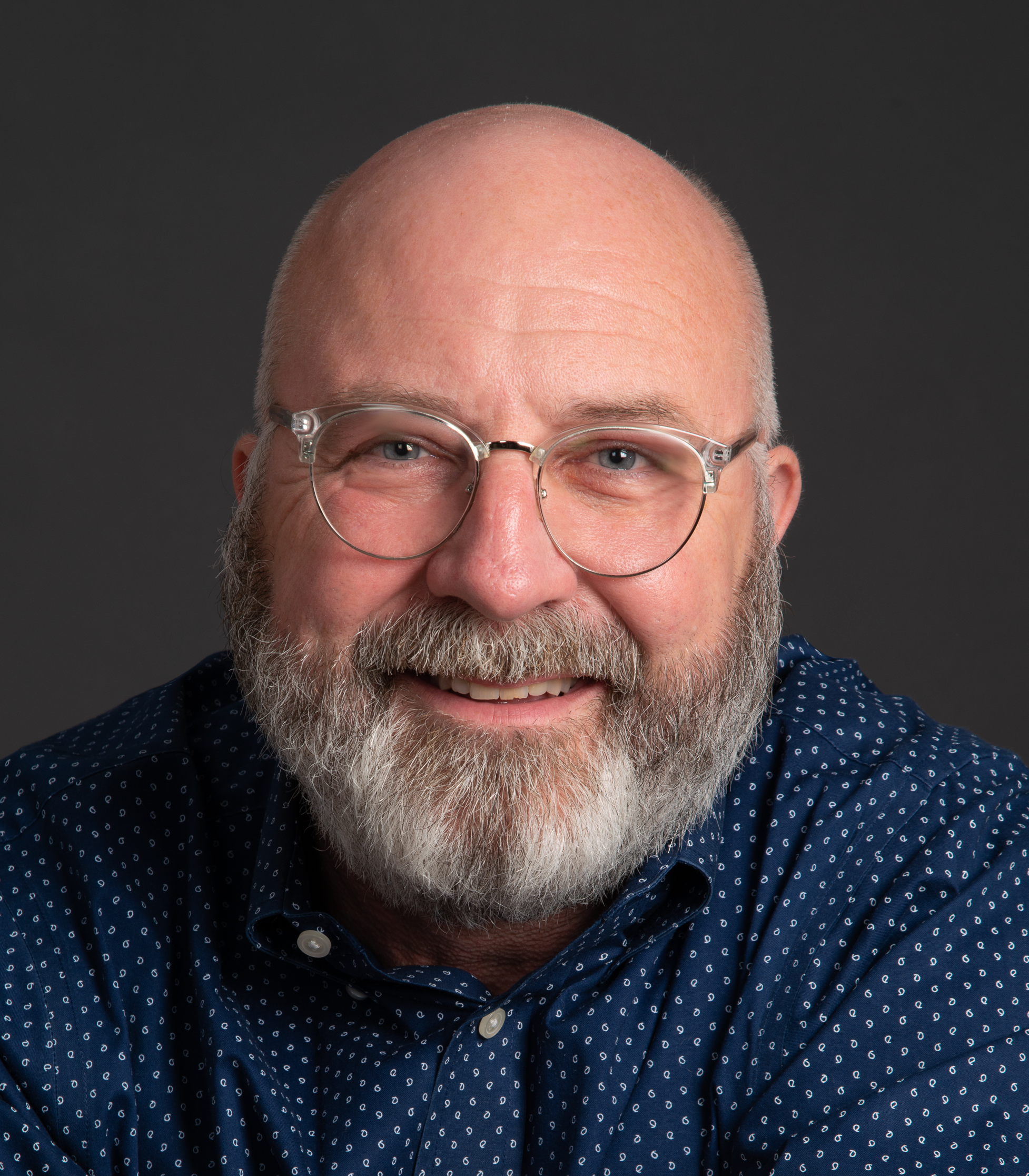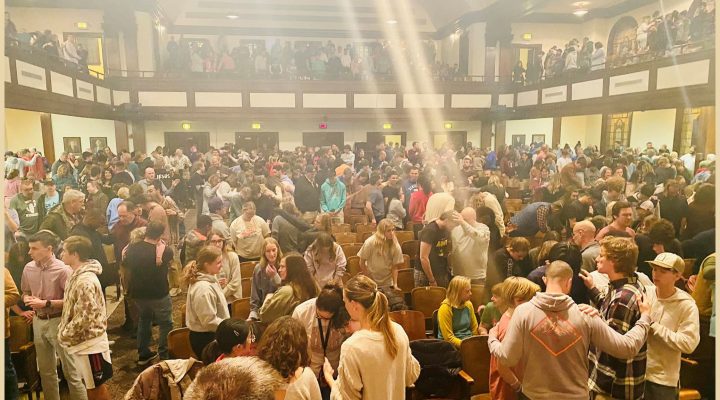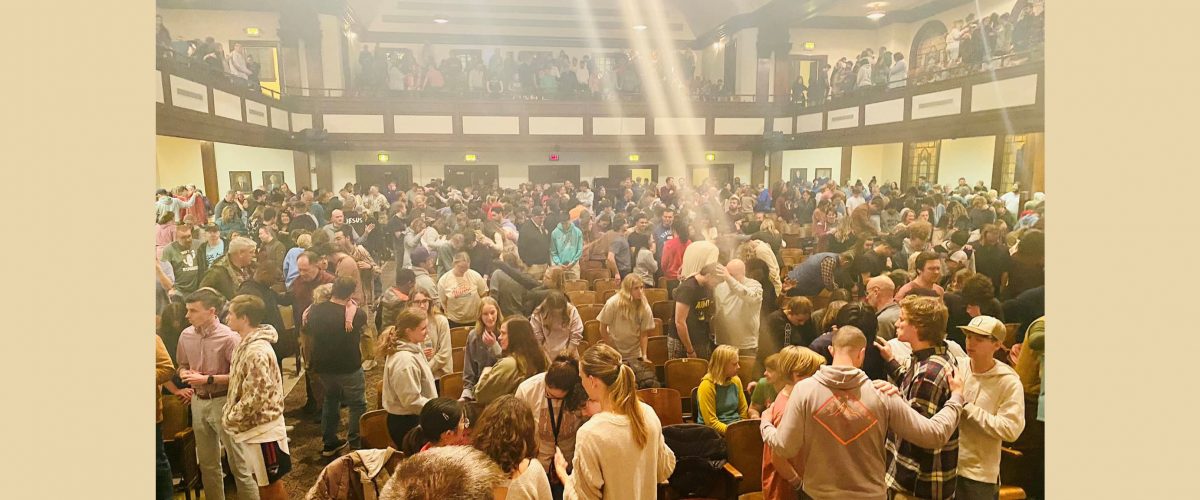“Revival” has got to be one of the most misused, misunderstood and abused words in the language of the church.
I grew up singing the old gospel hymn “Lord, Send a Revival,” so I’m well-soaked in the terminology. I’m even old enough to have attended more than my fair share of twice-a-year “revival meetings” at church. And I have lived and worked among Christians who pray fervently for “revival.”
Which is why news out of Asbury University in Kentucky has me raising a curious eyebrow. Like you, perhaps, I want to know more. (By the way, Asbury University is a distinct school from Asbury Seminary, although they are located adjacent to each other.)

Mark Wingfield
Here’s the setup: After last Wednesday’s chapel service, students didn’t leave the room. Instead, they felt compelled to stay and continue praying and singing. And they’ve been there ever since. This is being called a “revival.”
Some Christians are savoring this moment as a sign of God’s blessing, while others wonder if this is more performative piety than anything transformational. Time will tell.
There’s a history of “revival” at Asbury. The school’s website lists eight other instances of revival:
- “In February 1905, during a blizzard, a prayer meeting in the men’s dormitory spilled out to the rest of campus and the town of Wilmore.
- “In February 1908, revival broke out while someone prayed in chapel; the revival lasted two weeks and was signified by prevailing prayer and intercession.
- “In February 1921 the last service of a planned revival lasted until 6 a.m., and services were extended for three days.
- “In February 1950 a student testimony led to confessions, victories and more testimonies. This went on uninterrupted for 118 hours and became the second leading news story nationwide; it is estimated that 50,000 people found a new experience in Christ as a result of this revival and witness teams that went out from it.
- “In March 1958 revival began in a student fasting prayer meeting that spilled over into chapel and lasted for 63 hours.
- “On February 3, 1970, Dean Custer B. Reynolds, scheduled to speak in chapel, felt led to invite persons to give personal testimony instead. Many on campus had been praying for spiritual renewal and were now in an expectant mood. Soon there was a large group waiting in line to speak. A spirit of powerful revival came upon the congregation. The chapel was filled with rejoicing people. Classes were cancelled for a week during the 144 hours of unbroken revival, but even after classes resumed on February 10, Hughes Auditorium was left open for prayer and testimony. These sessions were presided over by Reynolds, Clarence Hunter and other faculty. Some 2,000 witness teams went out from Wilmore to churches and at least 130 college campuses around the nation.”
- “In March 1992 a student confession during the closing chapel of the annual Holiness Conference turned into 127 consecutive hours of prayer and praise.
- “In February 2006 a student chapel led to four days of continuous worship, prayer and praise.
Also note that Asbury is a Wesleyan school associated with the Wesleyan Holiness movement, which is distinct from and often at odds with Pentecostalism. That’s a column for another day, but for now, understand that Asbury’s culture is bent toward the supernatural more than most Methodist schools and seminaries.
And sometimes you get what you’re looking for.
Yet, given the culture of college campuses today — often populated with young “nones” — the fact that students would go to chapel and gladly stay afterward must account for something.
“My problem with talk of ‘revival’ is that it tends to celebrate an inward experience more than an outward expression of the kingdom of God coming on earth as it is in heaven.”
My problem with talk of “revival” — whether among Methodists, Baptists or anyone else — is that it tends to celebrate an inward experience more than an outward expression of the kingdom of God coming on earth as it is in heaven. I’ll admit I’m someone tuned toward action more than meditation, so maybe this kind of revival just isn’t my cup of spiritual tea.
I do remember a time as a young teenager when I had been invited by some older kids in the youth group to a prayer meeting at our Baptist church in central Oklahoma. We sang and prayed and felt overcome by the Spirit. The older kids were driving; I was not. So I had to go find a telephone (this was way before cell phones) and call my parents to beg, yea verily plead, to stay longer. They refused. I needed to come home now. My parents — highly devout people — certainly did not feel the Spirit the way I did that night.
And here is one of the great paradoxes of emotional spiritual moments: They don’t translate well to people who aren’t there. These are definitely “you had to be there” experiences.
That’s likely why Christians who long for revival are beating a path to Wilmore, Ky., right now, hoping to feel the Spirit. And it’s likely why the rest of us may scratch our heads and wonder if this is just a feel-good publicity moment — a “he gets us” that doesn’t cost millions of dollars.
While there certainly is a history of Spirit-fueled moments in European and American history — surely there are similar moments in other cultures; I’m just not well educated enough to address them — we need to consider the outcomes. It was Jesus who taught, “By their fruit you will know them.”
We know of the Great Awakening, the Second Great Awakening, the Azusa Street Revival. Each of these events spawned evangelistic efforts and even in some cases social justice advances. The Second Great Awakening, for example, played a role in the push to abolish slavery.
I can get on board with that kind of revival. A movement of the Spirit that compels the faithful to act justly, love mercy and walk humbly with God sounds fantastic. But a movement of the Spirit that wraps worshipers in a kumbaya moment that produces no fruit sounds like faith without works.
“The glow without the go is merely spiritual pleasure.”
Despite what some Calvinists and Pentecostals teach — that’s an interesting pairing, right? — worship of God is not an end unto itself. The glow without the go is merely spiritual pleasure.
Throughout the New Testament, the Holy Spirit compels believers to move beyond their mountain highs and take the good news to those in the valley below. The Day of Pentecost was not just a warm, fuzzy moment in a closed room. It empowered believers to spread the gospel far and wide. The Great Commission given by Jesus was not to stay here and feel happy; it was to go and tell. The women at the empty tomb did not build a shrine and stay there night and day worshiping. They ran to tell others.
If the current spiritual event at Asbury is to be considered a “revival,” it will propel students and others from that holy space to do the holy work of God — to heal the brokenhearted, to proclaim liberty to the captives and freedom to the prisoners.
If the current spiritual event at Asbury is to be considered a “revival,” it will lead worshipers to renounce the evils of Christian nationalism, which is a modern form of idolatry.
If the current spiritual event at Asbury is to be considered a “revival,” it will turn swords into plowshares. Contrast the wonderment in Wilmore with the pain being felt just 400 miles up I-75 by students at Michigan State University, where three students were shot dead on Monday while Asbury students were singing and praying.
Yes, America needs revival. We need a revival that will change our national attitudes and actions to look more like God’s faithful rather than God’s fearful.
If the current spiritual event at Asbury is to be considered a “revival,” it will produce fruit in keeping with repentance.
Anything less is just a warm spiritual hug that will wither like bluegrass.
Mark Wingfield serves as executive director of Baptist News Global. He is the author of the new book Honestly: Telling the Truth About the Bible and Ourselves.
Related articles:
What I witnessed this week at the Asbury revival | Analysis by Laura Levens
The State of the Union felt like an old-fashioned revival to me | Opinion by Jordan Conley
Bush calls for religious revival to help all Christians welcome immigrants
Where have all the revivals gone? | Opinion by Bill Leonard


